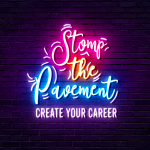After years working as a resume professional in a Career Services Office, I saw a TON of mistakes. These are the most common resume mistakes I saw and my tips to fix your resume asap!
A lot of these mistakes can also be deal breakers- especially if you’re up against a BIG stack of applicants. You want to make sure your resume stands out as one of the best- and avoiding these mistakes will help you get there!
Def don’t get upset if you’ve made these resume mistakes before- we all have! What’s important is that you learn and keep going!!
Keep reading to find out the most common resume mistakes, and how you can fix them to make sure your resume stands out for the best reasons!
The Most Common Resume Mistake: Using a resume template
When people need help writing a resume, they usually search for resume templates. But, it’s one of the biggest resume mistakes people make.
I KNOW the free resume templates on MS Word and the internet are so much easier than creating your resume from scratch. However, you shouldn’t use them. Why? Because of how easy they are!
They’re so easy and convenient that everyone is using them, which means your resume won’t stand out if you use one too. Your resume is about showing YOU and all the wonderful things you’ll bring.
You can’t show how your unique skills and experiences make you alone the best candidate if you’re using a template 50 other applicants have used!
After a few months as a resume professional, it became pretty easy for me to spot templates when students were using them. If I could recognize them after months of practice, imagine how well someone who has spent years in HR will be able to.
So, yes, you do have to build your resume from scratch. You can’t fall into the trap of using templates, because your resume will never shine as brightly if you do. It’s not the easy road, but it’s the one that’ll land you a job!
Still not convinced? Here’s more info about why free & paid resume templates are a bad idea!

Name is too small
The first thing I looked for when I saw a new resume was the size of the person’s name.
Your name should always, always, always be the biggest thing on the page. This resume is about YOU, so YOU need to stand out!
118 people (average) apply for a job, so you need to make sure whoever’s reading your application knows your name.
Don’t go overboard and make your name half the page, but your name should stand out on your resume.
The purpose of your resume is to make YOU and your abilities memorable! Make your name one they can’t miss!
80% OF JOBS ARE ON THE HIDDEN MARKET—
LEARN HOW TO FIND THEM IN THIS FREE WORKSHOP
Are online job apps making your career sour? The key to candy coating your career is networking!
In this FREE workshop, I’ll teach you how to ditch your resume & grow the best resource you have as a job seeker: your network!
Written in paragraphs
I cringe when I see paragraphs on a resume. Is that extreme? Maybe. But it’s something I saw all the time and it’s a HUGE resume mistake!
One big thing to consider when creating your resume is the reader’s experience.
You’re talking to them through this document and you need them to enjoy the conversation.
Picture them reading a huge stack of resumes for one position- do you think they’re going to take the time to read paragraphs of text? Or, will they see those paragraphs, think “ugh,” and toss your resume to the side?
Instead of paragraphs, write a bulleted list for each of your experiences.
Each bullet point should start with an action verb, like:
- Researched
- Managed
- Communicated
- Oversaw
They should also use language from the job description. Your experiences should each have between 2 and 6 bullets that paint a picture of YOU as an employee.
Paragraphs on a resume is one of the most common resume mistakes I’ve seen, and it’s also one of the quickest ways to get your resume thrown out or moved to the bottom of the pile.
Most bad resume examples show large chunks of text and long paragraphs, which turn your resume into an essay- and who actually likes reading essays?!
If you need help writing a resume, using bullet points instead of paragraphs is the best way to make it easier!
Inconsistent formatting
Consistency, consistency, consistency.
That’s what you need to think about when you’re writing your resume. Your resume’s format needs to be consistent.
This can get tricky- it’s looking at the details of your resume and making sure they match up throughout the entire document.
This includes how you format your headers, where you use bold and italicized text, and which side you line up your dates.
Again, this is about making your resume stand out from everyone else’s in that stack and creating a memorable experience for your potential employer. Show them details matter to you and you’re willing to take the time to make this perfect.
You’ll stand out if your resume is consistent and clear. As a resume professional, believe me, they’re digging through some terrible resumes.
Make sure your resume stands out by paying attention to all those little details that usually most people overlook- it’ll be worth it!
Poorly worded headers
This is one of the most common resume mistakes.
People will typically over categorize their experiences, which makes it difficult for your most relevant ones to stand out.
For example, clients usually split up their experiences by work, volunteer, and leadership- or something along those lines.
The secret, however, is that employers spend most of their time reading the top of your resume and the top of each section of your resume. This means the experiences most related to the job have to be at the top.
So, if you have a volunteer experience that’s almost identical to the position you’re applying for and your volunteer section is at the bottom of your resume, you risk your employer never seeing it.
Confused about writing a resume for each job? Check out these tips on writing a custom resume!
When you’re writing a resume, you should divide your experiences into just two simple categories: Related (or relevant) Experience and Additional Experience.
It’s such a simple resume fix and one I don’t see a lot of people doing. It guarantees your most important experiences are the stars of your resume. This brings the spotlight back to you and how perfect you are for this job!
80% OF JOBS ARE ON THE HIDDEN MARKET—
LEARN HOW TO FIND THEM IN THIS FREE WORKSHOP
Are online job apps making your career sour? The key to candy coating your career is networking!
In this FREE workshop, I’ll teach you how to ditch your resume & grow the best resource you have as a job seeker: your network!
Verb tense
Like I said before, each of your bullet points should start with an action verb. The verb tense is also important- don’t worry, I won’t go too English teacher here!
The verb tense should represent whether or not you’re still working in that position.
If you are, it should be in present tense. If you’re not, it should be in past tense.
If you’re not sure, use this little trick: read the bullet point, but put an “I” in front of the verb- if the sentence is accurate, so is your tense!
Also, never use punctuation at the end of your bullet points. Since they’re not complete sentences, they don’t need a period.
It’s the little things that will push your resume to the top of the pile, so it’s important to go through these little details!

Soft skills
THIS is something I had to talk about all the time as a resume professional- almost every resume I reviewed got it wrong.
The skills section on your resume, the one at the very bottom, is NOT for soft skills.
What’s a soft skill?
Soft skills are intangible: communication, leadership, teamwork, etc. You can’t really demonstrate or grasp it in any way.
It’s tempting to list these in your skills section, especially when the job description says that’s what they want you to have!
However, this section is for more tangible skills, like technology and language.
For example, if you’re an expert in fancy cameras or know how to code or can speak another language, list it in your skills section (if it’s relevant- if you’re applying to be an accountant, they don’t need to know you can use a DSLR).
So, how do you tell them about all your awesome soft skills if you can’t put them in your skills section?
You don’t.
Instead, you show them. Include examples in your bullet points and cover letter of you using those skills during your past positions.
For example, you could say, “Communicated my vision for the organization to a group of 20+ members” or “Led my team of 10 coworkers to success by assigning roles, facilitating group discussions, and mediating conflicts.”
Anyone can write “team player” and “great communicator” in a list, but not everyone will use examples to prove they actually are those things.
You’ll def stand out when you let your skills section serve the small purpose it’s meant to and word your bullet points with concrete examples that show your soft skills.
I’ve seen these common resume mistakes way too often, and they won’t help you stand out to an employer. Avoid making your name too small, using a template, writing in paragraphs, ignoring the details, over categorizing your experiences, and listing soft skills in your resume. Instead, focus on making your resume an amazing representation of you and everything you offer!
Ready to stop relying on writing resumes? Grab my guide on the 10 best strategies to network with confidence and transform your job hunt!







